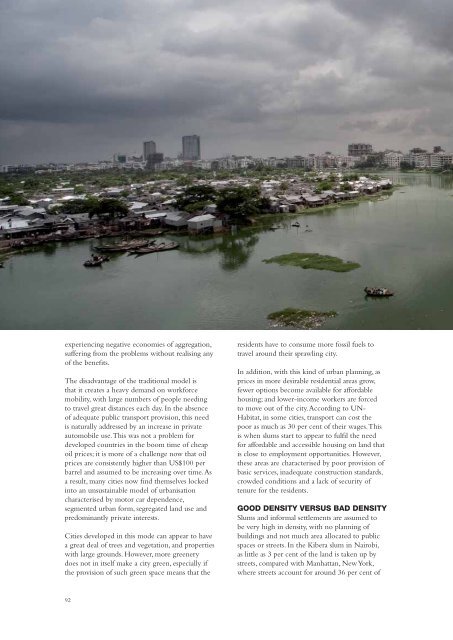Climate Action 2012-2013
Create successful ePaper yourself
Turn your PDF publications into a flip-book with our unique Google optimized e-Paper software.
experiencing negative economies of aggregation,<br />
suffering from the problems without realising any<br />
of the benefits.<br />
The disadvantage of the traditional model is<br />
that it creates a heavy demand on workforce<br />
mobility, with large numbers of people needing<br />
to travel great distances each day. In the absence<br />
of adequate public transport provision, this need<br />
is naturally addressed by an increase in private<br />
automobile use. This was not a problem for<br />
developed countries in the boom time of cheap<br />
oil prices; it is more of a challenge now that oil<br />
prices are consistently higher than US$100 per<br />
barrel and assumed to be increasing over time. As<br />
a result, many cities now find themselves locked<br />
into an unsustainable model of urbanisation<br />
characterised by motor car dependence,<br />
segmented urban form, segregated land use and<br />
predominantly private interests.<br />
Cities developed in this mode can appear to have<br />
a great deal of trees and vegetation, and properties<br />
with large grounds. However, more greenery<br />
does not in itself make a city green, especially if<br />
the provision of such green space means that the<br />
residents have to consume more fossil fuels to<br />
travel around their sprawling city.<br />
In addition, with this kind of urban planning, as<br />
prices in more desirable residential areas grow,<br />
fewer options become available for affordable<br />
housing; and lower-income workers are forced<br />
to move out of the city. According to UN-<br />
Habitat, in some cities, transport can cost the<br />
poor as much as 30 per cent of their wages. This<br />
is when slums start to appear to fulfil the need<br />
for affordable and accessible housing on land that<br />
is close to employment opportunities. However,<br />
these areas are characterised by poor provision of<br />
basic services, inadequate construction standards,<br />
crowded conditions and a lack of security of<br />
tenure for the residents.<br />
GOOD DENSITY VERSUS BAD DENSITY<br />
Slums and informal settlements are assumed to<br />
be very high in density, with no planning of<br />
buildings and not much area allocated to public<br />
spaces or streets. In the Kibera slum in Nairobi,<br />
as little as 3 per cent of the land is taken up by<br />
streets, compared with Manhattan, New York,<br />
where streets account for around 36 per cent of<br />
92












